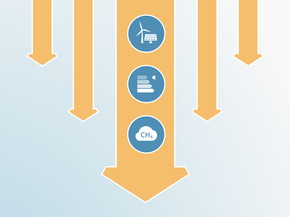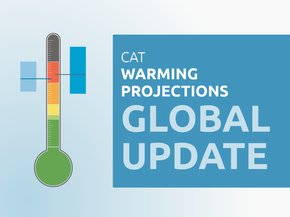Assumptions
Historical emissions
Historical emissions from 1990 to 2023 were taken from the PRIMAP National Historical Greenhouse Gas Emissions Database (Gütschow & Pflüger, 2023). The data is provided in AR5.
LULUCF data from 1990 to 2022 is taken from the Chile’s National Greenhouse Gas Inventory (INGEI) presented alongside Chile’s First Biennial Transparency Report (BTR1) to the UNFCCC (Ministerio del Medio Ambiente, 2023a). 2023 LULUCF data comes from preliminary estimates presented elsewhere in the BTR1.
NDC and other targets
No assumptions or calculations were made with respect to the unconditional NDC target for 2030 as it already included an absolute target for emissions excl. LULUCF. The NDC also included a peak year (2025) and an emissions budget (excl. LULUCF) for the period between 2020 and 2030 (Gobierno de Chile, 2020). These numbers were taken directly into our calculations and no additional assumptions were needed. Chile’s BTR1 clarifies that NDC monitoring uses IPCC AR5 GWPs, which we assume also applies to the target itself.
Current policy projections
Current policy projections have been harmonised to historical emissions up to 2022. We derive our current policy projections using a few different sources.
For the upper range of our current policy projections, we use:
- Energy CO2 emissions: based on the Asian and Pacific Economic Cooperation (APEC) 2022 Outlook. As this scenario includes all current key policies, no additional calculations were added. These policies include Chile’s Energy Efficiency Law, the retirement of coal plants by 2040, with 65% of coal plant capacity shutting down before 2025, the National Electromobility Strategy, as well as its Hydrogen Strategy (APEC, 2022).
- Energy non-CO2 emissions: based on non-CO2 emissions projections from the U.S. Environmental Protection Agency (U.S. Environmental Protection Agency, 2019).
- Industrial processes, agriculture, and waste emissions: based on Chile’s Fifth Biennial Update Report (BUR5) (Ministerio del Medio Ambiente, 2022).
- Other emissions: 10-year historical trend (2010-2019) from PRIMAP (Gütschow & Pflüger, 2023).
For the lower range of our current policy projections, we use:
- All sectors, including energy: based on the ”Plan Sectorial de Mitigación” projections from Centro de Energia (2025). The Base PSM scenario estimates and projects GHG emissions from 2020 –2030, considering the implementation of all mitigation measures at their most ambitious levels. Emissions were extended to 2035 using the Carbon Neutralidad (CN1) scenario, based on post-2030 PSM information.
We also compared our current policy projections to those from Observatorio de Carbono Neutralidad (across all sectors) harmonised to 2022 emissions, but this currently falls between the lower and upper end of our CPP (Observatorio de Carbono Neutralidad, 2024).
Some policy developments such as the update on the Distributed Generation Law (also referred to as the “Net Billing” Law) (Law 20.571), which triples the capacity threshold for installed capacity for projects of self-consumption, are not quantified due to lack of available data.
Net-zero target and other long-term targets
Chile has committed to being net-zero by 2050. According to Chile’s long-term strategy submitted to the UNFCCC, the target includes a LULUCF sink of 65 MtCO2e to neutralise remaining emissions. Thus, we estimate Chile’s total GHG emissions excluding LULUCF in 2050 to be 65 MtCO2e (Gobierno de Chile, 2021).
Global Warming Potentials values
The CAT uses Global Warming Potential (GWP) values from the IPCC's Fifth Assessment Report (AR5) for all its figures and time series. Assessments completed prior to June 2025 (COP24) used GWP values from the Fourth Assessment Report (AR4), and those completed prior to December 2018 (COP24) used GWP values from the Second Assessment Report (SAR).
Black carbon
Black carbon can have both a warming and a cooling effect in the atmosphere, depending on where it is: black carbon on snow reduces the albedo of the surface and thus leads to warming. It also leads to higher local temperature of the snow and thus to higher rate of snow melt. Both cooling and warming effects can emerge from interferences with other particles in the atmosphere (depending on the exact conditions). The IPCC’s 6th Assessment Report (AR6) indicates a net-positive effect of black carbon on warming over time, i.e. in sum, black carbon has contributed more to warming than cooling over the last centuries (Szopa et al., 2021). AR6 also reports an increase in the radiative forcing of black carbon over time, meaning that the warming effects are growing more strongly than the cooling effects.
The IPCC concludes that reducing emissions of black carbon (as well as other anthropogenic emissions like methane) in the short term would contribute to limiting temperature increase to 1.5°C. Along with the decarbonisation of the energy system that is required for 1.5°C, black carbon decreases in the 1.5°C compatible scenarios analysed in the IPCC's 6th Assessment Report.
The climate response of black carbon differs from greenhouse gases in terms of the geographical reach of its impacts, its lifetime, and its interactions with other particles and gases in the atmosphere. The IPCC therefore does not provide any estimate of the global warming potential of black carbon.
Further analysis
Latest publications
Stay informed
Subscribe to our newsletter




